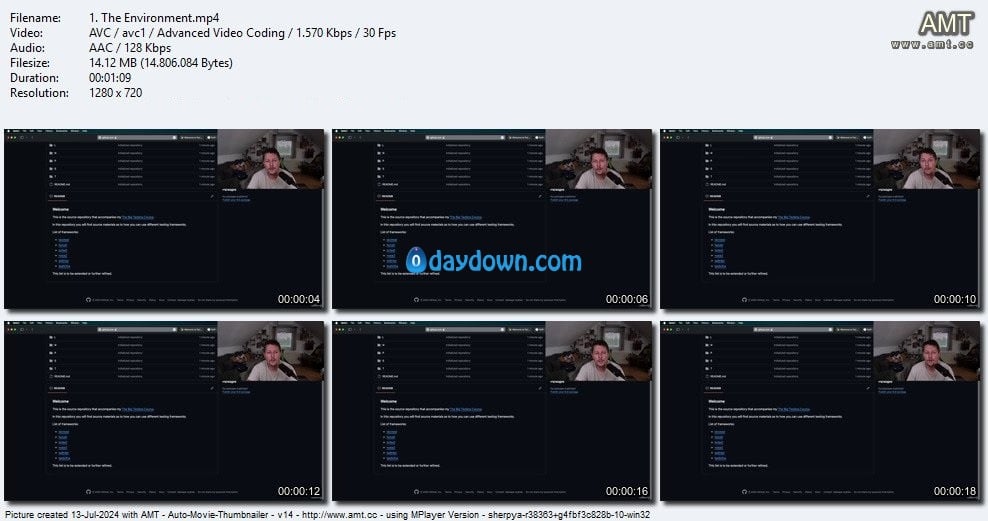
Published 7/2024
Created by Szabó Dániel Ernő
MP4 | Video: h264, 1280×720 | Audio: AAC, 44.1 KHz, 2 Ch
Genre: eLearning | Language: English | Duration: 27 Lectures ( 3h 3m ) | Size: 1.9 GB
A deep dive into testing your code
What you’ll learn:
testing
python
nose2
testinfra
splinter
doctest
Requirements:
beginner python
beginner linux
Description:
Welcome,This course is the cumulation of all the years of experience I have with python. My idea was to create a course that provides you with an anchor point into testing code you write from different aspects.The following popular modules are introduced and provided with real-world examples.- doctest- pytest- nose2- locust- testinfraAbout doctest. The doctest module searches for pieces of text that look like interactive Python sessions, and then executes those sessions to verify that they work exactly as shown. There are several common ways to use doctest:To check that a module’s docstrings are up-to-date by verifying that all interactive examples still work as documented.To perform regression testing by verifying that interactive examples from a test file or a test object work as expected.To write tutorial documentation for a package, liberally illustrated with input-output examples. Depending on whether the examples or the expository text are emphasized, this has the flavor of “literate testing” or “executable documentation”.About pytest. It helps you write better programs. The pytest framework makes it easy to write small, readable tests, and can scale to support complex functional testing.Features: Detailed info on failing assert statements (no need to remember self.assert* names)Auto-discovery of test modules and functionsModular fixtures for managing small or parametrized long-lived test resourcesCan run unittest (including trial) test suites out of the boxPython 3.8+ or PyPy 3Rich plugin architecture, with over 1300+ external plugins and thriving communityAbout nose2. The nose2 module in Python is a test runner that extends the built-in unittest framework to make it easier to discover, run, and report on tests. It is the successor to the older nose testing framework and provides a variety of features to improve and simplify the testing process. Here are some key aspects of nose2:Automatic Test Discovery: nose2 automatically discovers and runs tests by searching for files and directories that match a certain pattern (typically those that start with test or end with .py). This eliminates the need to manually specify test files.Plugins: nose2 is highly extensible and supports plugins that can add or modify functionality. There are built-in plugins for features like test coverage, profiling, and more, and users can write their own custom plugins.Configuration: It allows configuration via a unittest.cfg file, which can be used to set options for nose2 and its plugins. This makes it easy to manage test settings and preferences.Test Output: nose2 provides enhanced test output and reporting. It can output results in various formats and provides more detailed information compared to the default unittest runner.Test Fixtures: It supports unittest fixtures (setup and teardown methods), allowing you to prepare the environment before tests run and clean up afterward.Test Suites: nose2 can run specific test suites, allowing you to group tests logically and run them together.Parallel Testing: It supports running tests in parallel, which can significantly speed up the testing process, especially for large test suites.Overall, nose2 enhances the unittest framework by providing more powerful and flexible test discovery, execution, and reporting capabilities, making it a popular choice for many Python developers.About locust. The locust module in Python is an open-source load testing tool that allows developers to simulate and test the performance of web applications. It is designed to be easy to use and extendable, making it suitable for testing the scalability and robustness of web services. About testinfra. The testinfra module in Python is a testing framework used for verifying the state and configuration of infrastructure. It is particularly useful for ensuring that servers are configured correctly and that infrastructure-as-code (IaC) deployments are functioning as expected.The course is supported by a github repository where you will find all the demo examples.
Password/解压密码www.tbtos.com
